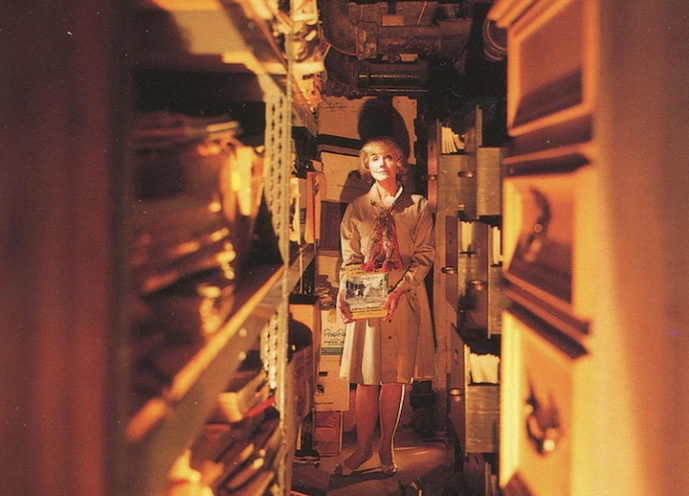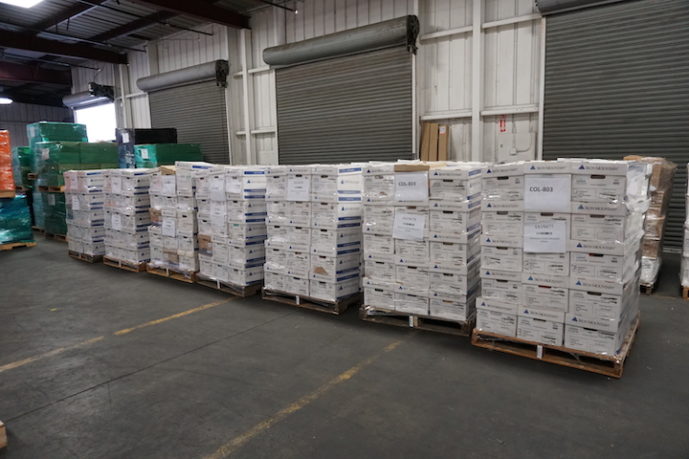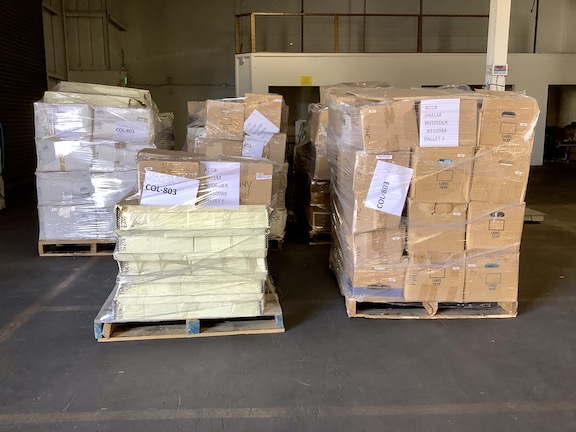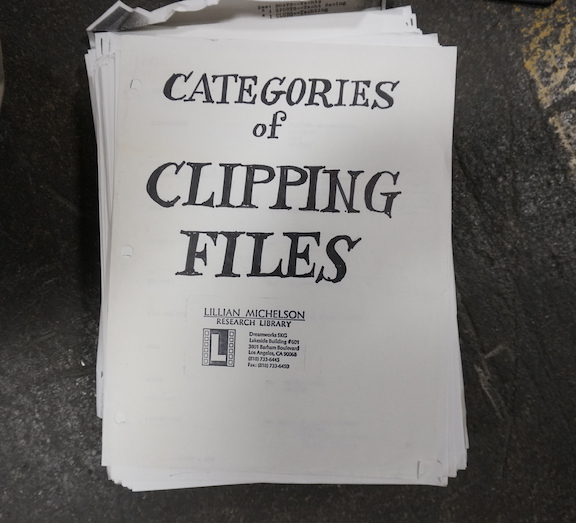Click here to print
A Lifetime of Movie Research, Digitized
posted February 2, 2021

Lillian Michelson among her enormous collection. Image: Save Lillian’s Library Fund
For decades, Lillian Michelson performed research in support of Hollywood film producers, directors, designers, and other creatives.
With material she gathered in the course of her work, in 1969 she began the Cinema Research Library that now bears her name.
A new chapter in the vast collection has begun with Michelson’s donation of the material to the Internet Archive. On 27 January 2021, a virtual ribbon cutting marked the handover of the material. Lillian Michelson, now in her 90s, unveiled the first tranche of the collection’s digitization, housed on the Internet Archives’ digital platform, archive.org.
More of the collection — as much as it is possible to digitize — will be added gradually, and will be free for anyone to use, enthusiasts as well as designers, filmmakers, and researchers in search of information and visual inspiration. “It will be open to everybody,” Michelson said.
“The Michelson Cinema Research Library has been looking for a digital home for a long time and this means that its important materials will be available forever with 24/7 access throughout the world,” said Thomas Walsh, former president of the Art Directors Guild and one of the organizers of the transfer for the Save Lillian’s Library Fund.
The renowned collection runs to 5,000 books dating back to the 1800s, as well as periodicals, more than 30,000 photographs (architectural, set decoration, prop, and set stills), more than one million clips in clipping files, scrapbooks, set drafts, production notebooks, and other ephemera. In all, the material filled two 18-wheel tractor trailers with 1600 boxes on 45 pallets for the move to the Internet Archives’ facility in the San Francisco Bay Area.

A small part of the Michelson Library collection. There’s a lot of it! Photos: Rick Prelinger, Internet Archive, September 2020, Richmond, California.
Hollywood abounds with film workers who have made use of the hard-copy collection; to familiarize them and others with the digital version, the Internet Archive has posted a guide to the Michelson Cinema Research Library.
The Internet Archive has existed since 1996 as a digital repository of just about anything the Internet holds or has held (the latter, thanks to the Archive’s Wayback Machine, a virtual warehouse of 475 billion webpages) or that can be added to it — books, films, video games, audio recordings, whatever.
The Internet Archive can lay claim to being one of the largest libraries in the world, with more than 1.5 million patrons each day accessing some of the repository’s 70 petabytes of data, with material gathered not only online but from more than 800 participating library and university partners.
The rollout of the Michelson library on the Internet Archive was a limited affair — for now, it has provided access to just a couple hundred boxes of digitized material. “Not to be a fully usable collection, but to show there’s progress,” Brewster Kahle, the Internet Archive’s Founder and Digital Librarian, told Moving Image Archive News.
As for Lillian Michelson, she said of the preservation of her library: “I feel as if a fantasy I never, never entertained has been handed to me by the universe, by fate.”
 Her extraordinary collection, which she compiled with her husband Harold Michelson, a renowned Hollywood storyboard artist and production designer who died in 2007, has long been a godsend for film workers. It has provided details about subjects, locations, and design concepts that inform and fill Hollywood productions — images and ideas relating to place, spaces, architecture, costumes, towns and cities, foreign countries, crime, the old West…
Her extraordinary collection, which she compiled with her husband Harold Michelson, a renowned Hollywood storyboard artist and production designer who died in 2007, has long been a godsend for film workers. It has provided details about subjects, locations, and design concepts that inform and fill Hollywood productions — images and ideas relating to place, spaces, architecture, costumes, towns and cities, foreign countries, crime, the old West…
In the course of a 60-year career, Lillian Michelson was considered the industry’s premier researcher, working on hundreds of films and television series. She mentored generations of film archivists and researchers, and over the years took her collection to various studios. In 1969 the owners of the Samuel Goldwyn Studios, responding to the break-up of the old studio system, said the library would have to find a new home. Lillian Michelson borrowed $20,000 against her husband’s insurance policy to purchase the reference library from Goldwyn Studios film librarian Lelia Alexander. The trove then went to the American Film Institute, Paramount Studios, and Zoetrope Studios at the invitation of Francis Ford Coppola. Michelson next received an offer from Jeffrey Katzenberg to move the Library to the newly opened DreamWorks Studios, and it remained there for 19 years, until her retirement. Then it went into storage.
More details of the collection’s peripatetic history can be found in an LA Times article in August 2020 and another in late January 2021.
Michelson was the generally uncredited researcher on scores of Hollywood films by the likes of Alfred Hitchcock, Steven Spielberg, Mel Brooks, Stanley Kubrick, and Roman Polanski including Scarface, Full Metal Jacket, Fiddler on the Roof, Rosemary’s Baby, Reds, The Right Stuff, and The Birds.
Coppola, who invited Michelson to move her library to the grounds of his Zoetrope Studios, said in a statement: “Lillian Michelson opened my eyes to the importance of a research library to all aspects of motion picture production. At a time when the rich and deep research libraries created and maintained by the motion picture studios were being ‘given away’ or otherwise destroyed, Lillian was a beacon of light guiding us to consider them as treasure.”
In recognition of Lillian Michelson’s collecting accomplishment, several organizations sought to host parts of her collection, but she long aspired to keep it all together. As she compiled it with her husband’s support, it clearly had great sentimental as well as practical value to her.
 Lillian Michelson — then Lillian Harber — met Harold Michelson in Miami before World War II. After he served in the US Air Force, he moved to Los Angeles and began a fabled career as a storyboard artist. Lilian Harber joined him; they married in 1947 and had three children. She found volunteer work in film library research. She first collected material for a library at the Pickford-Fairbanks Studio, then United Artists, and finally Samuel Goldwyn Studios.
Lillian Michelson — then Lillian Harber — met Harold Michelson in Miami before World War II. After he served in the US Air Force, he moved to Los Angeles and began a fabled career as a storyboard artist. Lilian Harber joined him; they married in 1947 and had three children. She found volunteer work in film library research. She first collected material for a library at the Pickford-Fairbanks Studio, then United Artists, and finally Samuel Goldwyn Studios.
In an interview, Internet Archive founder and Internet Hall of Fame member Brewster Kahle said that at the Archive, “we haven’t talked as much about collections and collecting and what they’ve bought to their fields” as about Internet sites and the like. He said he considered the Michelson Library a rewarding addition, capturing as it does the role a collection can play in a community, and that communities can play in the creation of collections.
“It’s fascinating for a word guy like me to see a collection of things that were collected really primarily for their visual context. It all seems like an intellectual hodgepodge unless you see it from that angle.”
The Internet Archive is starting to receive more whole libraries, he said. (Also recently added has been the library of the shuttered Marygrove College, in Detroit.) And, “a full library is more than a collection of books; it’s the center of a community.” He said he thinks of whole libraries, even when digitized, as “evidence of people having worked together, and of what they’ve thought. They’re worth preserving as a whole.”
The Archive’s approach, then — in such cases as collections of Argentinian tango recordings on 78rpm platters — is “we keep it whole physically, and digitize them and make the collection navigable.”
Apart from anything else, “that helps to say thank you to someone who did a lot of work, who spent a lifetime collecting, in some cases.”
Of course, he adds, the Michelson Library has a special place in a particular field of activity, but it’s one that has broad appeal. He includes himself in that catchment, saying he has often admired Hollywood films for “their attention to detail. I’m starting to know now how they did that.”
He said the Michelson collection’s richness and variety continues to hold lessons for film researchers, nowadays: “I worry that if we send interns off to do Google searches, we won’t have the integrity of movies that went back to, for example, original architecture magazines of the 1930s or pictures brought back from China.
Cutting the Ribbon
The January 27 online ribbon cutting included a panel discussion with Kahle and others about the Michelson collection and a screening of of Harold and Lillian: A Hollywood Love Story. That’s a documentary produced and directed by Academy Award-nominated Daniel Raim that was released to theaters in 2017 and screened in 68 US cities and 12 other countries. It was screened for television by Turner Classic Movies (TCM), and is available through streaming services Kanopy, Amazon Prime, and Apple TV.
The charming film includes recollections about the Michelsons, and testimonials to them, from such figures as Danny DeVito (the film’s executive producer), Coppola, and many others. With film clips, conversations with Lillian and Harold Michelson, and even examples of their love letters, it’s a celebration not only of their fabled accomplishments in film — although far from its limelight — as well as of them.
The Michelson Library’s move to a digital platform was accomplished with the hard labors of Save Lillian’s Library Fund volunteers. Among their contributions was to raise money to liberate the library’s assets from a storage facility where it had been locked in by overdue rent.
The Fund will now focus on building a new website with simple, intuitive navigational tools — the goal will be to help users use the digital library. The Internet Archive also is looking for supporters, to help with the cost of digitizing the collection.
The ultimate goal of the Michelson Library nonprofit, which is guided by a group of archivists and film makers, producers, and designers, is to build a community storage facility for any and all historic cinema research materials that have, as the Fund’s promotional material puts it, “been abandoned by the industry and rejected by our leading cultural, educational, and media institutions.” It would be a “dynamic and media-centric cinematic research library and service…designed and engineered to meet the workflow requirements of the digital age and the 24/7 demands of the national and global motion picture production workspace.”
That’s the sort of safe port that the Michelson Library is now entering.
— Peter Monaghan
Printed from Moving Image Archive News: http://www.movingimagearchivenews.org
URL to article: http://www.movingimagearchivenews.org/a-lifetime-of-movie-research-digitized/
Click here to print